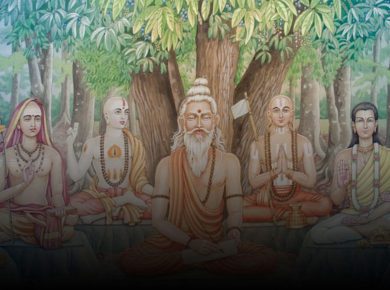Temple Architecture in South India – Dravida Style
Four stages of temple architecture had been observed in South India – Mainly during the Pallava’s rule, around 6th century AD which are as follows:
Stage 1 – Mahendra Group
- Marked the beginning of Rock cut cave architecture.
- Word Mandap was used instead temple.
Stage II – Narsimha Group
- Major development during this period was initiation of Decoration in rock cut cave structures.
- The architecture is represented by Monolithic rocks.
- Mandap’s now became ‘Ratha’s’ which is a refined cave, famous for beauty.
- The biggest Ratha was called as Dharamraj Rath and smallest one was called as draupadi Rath.
- Dharamraj Rath is considered as precursor of Dravidian style of temple making.
Stage III – Rajsimha Group
- At this stage the real structural development of temple’s started, and it moved outside the cave, earlier temples were part of caves.
- Example: Shore temple at Mahabalipuram, (TN) Kailashnath temple at Kanchipuram [arr] largest single work of art ever undertaken in India

Shore Temple at Mahabalipuram

Kailashnath Temple at Kanchipuram
Stage IV – Nandivarman Group
- It is said to be the declining stage of south Indian temple architecture and only small temples were constructed in this period.
- Notable examples [arr] Vaikundaperumal temple, Tirunelveli and Muktheswara temple
Dravida Style
- Deployed for Hindu temples in Tamil Nadu from the 7th to 18th century, characterized by its pyramidal tower.
- Unlike the nagara temple, the Dravida temple is enclosed within a compound wall.
- The front wall has an entrance gateway in its centre, which is known as Gopura/ Gopuram.
- Consists of a square-chambered sanctuary topped by a superstructure or tower (Vimana)
- Consists of an attached pillared porch or hall (Mandapa) which precede the door leading to the nucleus cell.
- The vimana is like a stepped pyramid that rise up geometrically rather than the curving shikhara of north India.
- Each story is delineated by a parapet of miniature shrines, and barrel-vault roofs at the centre.
- The tower is topped by a dome-shaped cupola and a crowning pot and finial.
- A large water reservoir or a temple tank enclosed in the complex is general in south Indian temples.
 Brihadeshwara Temple at Thanjavur
Brihadeshwara Temple at Thanjavur
- The origins of the Dravida style can be observed in the Gupta period.
- The earliest examples include 7th century rock-cut shrines at Mahabalipuram and a developed structural temple, the Shore Temple at the same site.
- Finest examples are Brihadeshwara temple at Thanjavur, built about 1010 by Rajaraja 1, & temple at Gangaikonda Cholapuram, built about 1025 by his son Rajendra Chola.
- Subsequently, a number of successive court enclosures, each with its own gateway (Gopurams), were added.
- By the Vijayanagar period (1336–1565) the Gopurams had increased in size so that they dominated the much smaller temples inside the enclosures.
Sub Styles of Dravida Temples
Vijaynagar Legacy
- They introduced the concept of enlarged high enclosure walls and more decoration on these high enclosure walls and Gopuram’s.
- Sculpture or motif of supernatural horses was used very frequently.
- They also introduced the concept of secular buildings (Example-Lotus Mahal).
- Typically, Vijaynagar period structures in the temple are the Amman Shrine (male deity of temple)
Lotus Mahal
Nayaka Style
- The Nayakas rose on the fall of Vijayanagara empire.
- The most famous architectural landmark of this period is the Meenakshi- Sundareswara temple at Madurai.
- The great temple complex has actually two shrines; the first one dedicated to Shiva as Sundareswara and the second one to his wife Meenakshi.
- Have all the features of Dravidian style with an additional prominent feature known as ‘Parakram’s
- Parakram’s are huge Corridore’s along with roofed ambulatory passageways. It served to connect various parts of temple while enclosing certain areas.
- Intricate carvings are seen all across the temple walls.
- The large tank set slightly off the axis to the main temple is another impressive feature of the temple.
- Surrounded by steps and a pillared portico, the tank was used for ritual bathing.
Meenakshi- Sundareswara Temple
Chola Sculpture: NATRAJ
- Shiva’s dancing position is associated with the end of the cosmic world
- Shiva has been shown balancing himself on his right leg and suppressing the apasmara, the demon of ignorance or forgetfulness, with the foot of same leg.
- Shiva raises his left leg in bhujangtrasita stance, which represents tirobhava that is kicking away the veil of maya from the devotee’s mind.
- His four arms are outstretched, and lower right hand is posed in Abhayahasta mudra
- The upper right-hand hold & Damaru
- The upper left hand is held in dola hasta and connects with the Abhaya hasta of the right hand.
- His Hair flocks fly on both the sides touching the circular Jwala mala or the garland of flame, which surrounds the entire dancing figuration.
Vesara Style/Chalukya Style/Karnataka Style
- This style has features of both Nagara and Dravidian style.
- It consists of two principle components like Dravidian style i.e., Vimana & Mandap.
- Departing from Dravidian style it does not have covered ambulatory around the sanctum.
- Example: Lad Khan temple at aihole, Temples at Badami, Virupaksha temple – Pattadakal, Hoysala temples at Karnataka.

Virupaksha Temple – Pattadakal

Hoysala Temple













3 comments
Temple architecture, is well written and is all new information.
Where can i find more about – Srirangam Lord Ranganatha Temple architecture. It’s absolutely amazing architecture & sculpture at this biggest temple in the world. They must have been a different breed of Indians, because Indians today are finding it impossible to build roads, drainage, and town planning.
Thank you so much for the article. -Vidya
please include “hoysala temple architecture” in the temple art of south India section……!.
#Respect 🙂 🙂